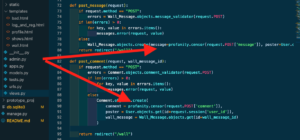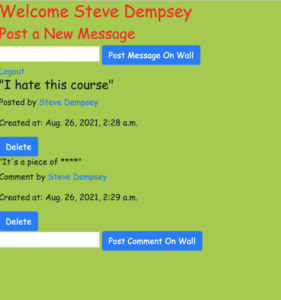When I tackled my first website, I decided to play it conservatively. I was trying to survive Coding Dojo, a rough boot camp dedicated to web development, and I wanted to stay within my skill level. A few other students knocked out some excellent websites, while others began something big and drowned in code. I did not want to be the latter, but I knew I couldn’t compete with the former. I was somewhere in the middle.

So, I went to my bread-and-butter, and that’s golf. I have been golfing for several years and thought this might make an excellent subject for a website. The question was, what can I do based on golf and my lack of skill level? I’ve played on a dozen or so courses in Northern California but didn’t feel qualified to rate the best courses in our region. And, god forbid, I am not qualified to give tips. I only took one lesson, which shows in my game.
Still, I wanted to do something golf related. Then I thought, why does this have to be serious? So I devised the idea to show bad golfers they could play on good golf courses. I took my best advice and turned it into a website, telling golfers to focus on keeping the ball on the fairway and, when (not if) something goes wrong, punch it back on the fairway and move on. Who cares about your score? If you have to eat a stroke or two, so be it.
Essentially, leave the instructional websites to the experts.
As far as coding, I used HTML, CSS, Java, Django, and Python. Pretty much my go-to for building websites. Also, I seem to be getting pretty good at using code from other sources. Thanks to those who contributed to my cause (and you didn’t know you were contributing).
My Website Was Vulnerable to Attack
The idea for this website was essential, and my goal was to get it to function and worry about other things later. The plan was to do an introductory video on the home page along with a login/registration form. That took users to the second page, where I created a list of golf courses users can be challenged with but still have a good time. It contained a short write-up of each course with links to each course.
From there, users were directed to a wall where they could leave messages and make comments. This page was a make-or-break for my site. My purpose was to involve users on the site and hear their opinions. I thought this was a fantastic way to include users. So I put everything together, but I thought, what if some jerk got on the site and started spilling nasty words on the wall? Don’t you think that wouldn’t happen? Think again. I was like, this significant element (the wall) could destroy my website. I was too deep to give up.

There are profanity blockers, but I had trouble finding the correct code to fit. I started to get discouraged, but I wouldn’t give up. With the help of a teacher’s assistant at Coding Dojo, we found an element called profanity.censor that would adapt to Python from geeks-for-geeks. In my views section of the website, the profanity.censor code was put into the post_message and post_comment areas, as demonstrated in the lead image.
If someone tries to write some profanity, stars will appear. Some words have all stars on them. I was hoping that when someone sees that, it would discourage them from other vulgarity.
If you plan to invite discussion among users, I suggest using a profanity blocker. It beats monitoring the website 24/7 to ensure everything is clean and you have peace of mind.
About The Author

Steve Dempsey
Steve Dempsey has worked for a variety of news organizations for nearly 40 years. The majority of Steve's work came in sports, including covering the NFL, Major League Baseball, NBA, golf, and motorsports. Steve also wrote editorials in Opinion along with hosting a live-stream online show covering many topics. Steve is also an experienced web designer and CMS operator. He recently completed a web development boot camp named Coding Dojo.
Why You Need a Profane Blocker
When I tackled my first website, I decided to play it conservatively. I was trying to survive Coding Dojo, a rough boot camp dedicated to web development, and I wanted to stay within my skill level. A few other students knocked out some excellent websites, while others began something big and drowned in code. I did not want to be the latter, but I knew I couldn’t compete with the former. I was somewhere in the middle.
So, I went to my bread-and-butter, and that’s golf. I have been golfing for several years and thought this might make an excellent subject for a website. The question was, what can I do based on golf and my lack of skill level? I’ve played on a dozen or so courses in Northern California but didn’t feel qualified to rate the best courses in our region. And, god forbid, I am not qualified to give tips. I only took one lesson, which shows in my game.
Still, I wanted to do something golf related. Then I thought, why does this have to be serious? So I devised the idea to show bad golfers they could play on good golf courses. I took my best advice and turned it into a website, telling golfers to focus on keeping the ball on the fairway and, when (not if) something goes wrong, punch it back on the fairway and move on. Who cares about your score? If you have to eat a stroke or two, so be it.
Essentially, leave the instructional websites to the experts.
As far as coding, I used HTML, CSS, Java, Django, and Python. Pretty much my go-to for building websites. Also, I seem to be getting pretty good at using code from other sources. Thanks to those who contributed to my cause (and you didn’t know you were contributing).
My Website Was Vulnerable to Attack
The idea for this website was essential, and my goal was to get it to function and worry about other things later. The plan was to do an introductory video on the home page along with a login/registration form. That took users to the second page, where I created a list of golf courses users can be challenged with but still have a good time. It contained a short write-up of each course with links to each course.
From there, users were directed to a wall where they could leave messages and make comments. This page was a make-or-break for my site. My purpose was to involve users on the site and hear their opinions. I thought this was a fantastic way to include users. So I put everything together, but I thought, what if some jerk got on the site and started spilling nasty words on the wall? Don’t you think that wouldn’t happen? Think again. I was like, this significant element (the wall) could destroy my website. I was too deep to give up.
There are profanity blockers, but I had trouble finding the correct code to fit. I started to get discouraged, but I wouldn’t give up. With the help of a teacher’s assistant at Coding Dojo, we found an element called profanity.censor that would adapt to Python from geeks-for-geeks. In my views section of the website, the profanity.censor code was put into the post_message and post_comment areas, as demonstrated in the lead image.
If someone tries to write some profanity, stars will appear. Some words have all stars on them. I was hoping that when someone sees that, it would discourage them from other vulgarity.
If you plan to invite discussion among users, I suggest using a profanity blocker. It beats monitoring the website 24/7 to ensure everything is clean and you have peace of mind.
Related Posts
The Painful Truth of Subscription TV Services
Which Royal Family Member Are You, According to the Horoscope?
Why Not Use an Air Fryer to Make Your Fries
About The Author
Steve Dempsey
Steve Dempsey has worked for a variety of news organizations for nearly 40 years. The majority of Steve's work came in sports, including covering the NFL, Major League Baseball, NBA, golf, and motorsports. Steve also wrote editorials in Opinion along with hosting a live-stream online show covering many topics. Steve is also an experienced web designer and CMS operator. He recently completed a web development boot camp named Coding Dojo.